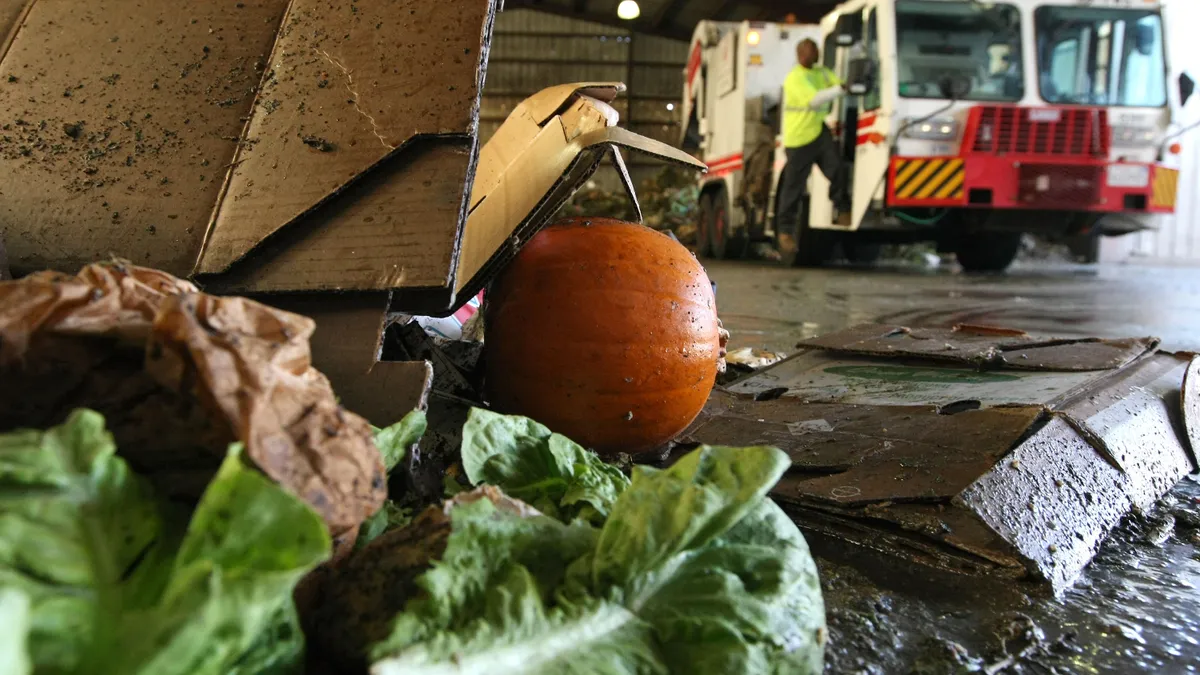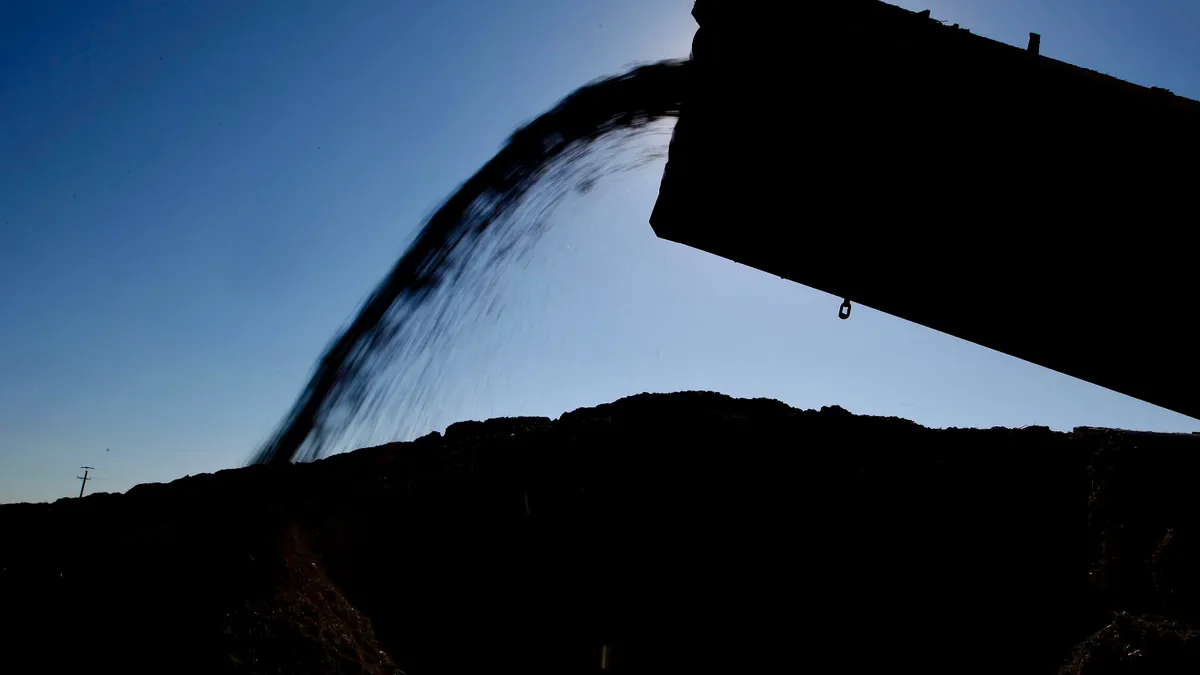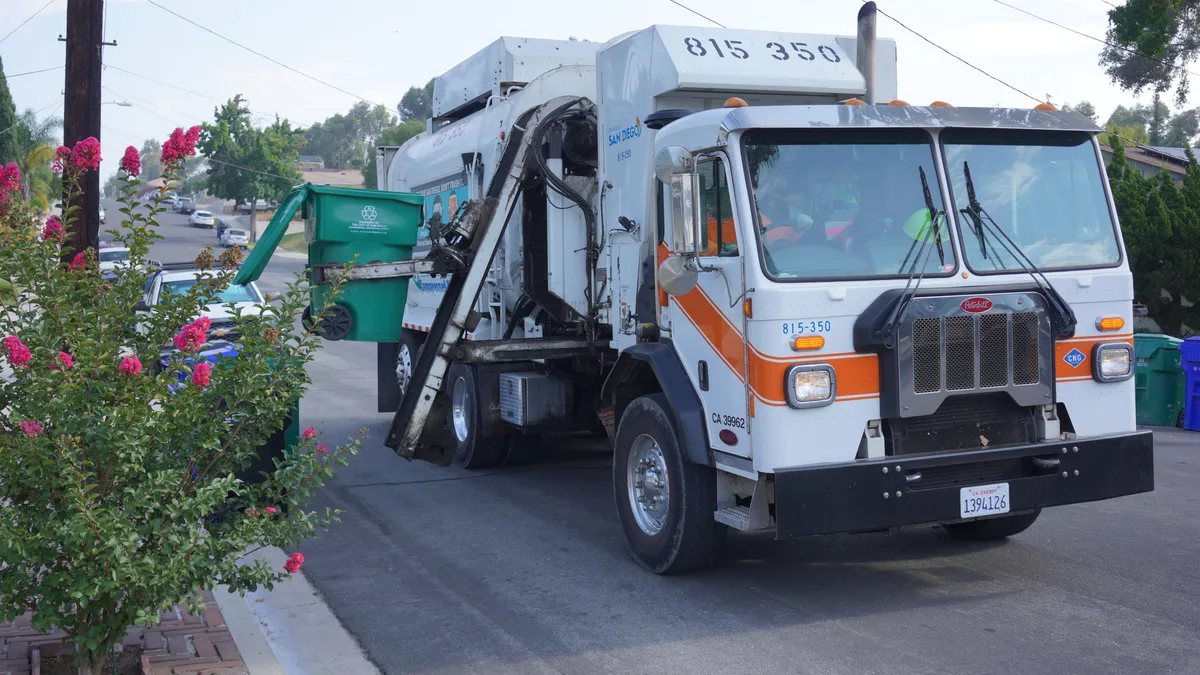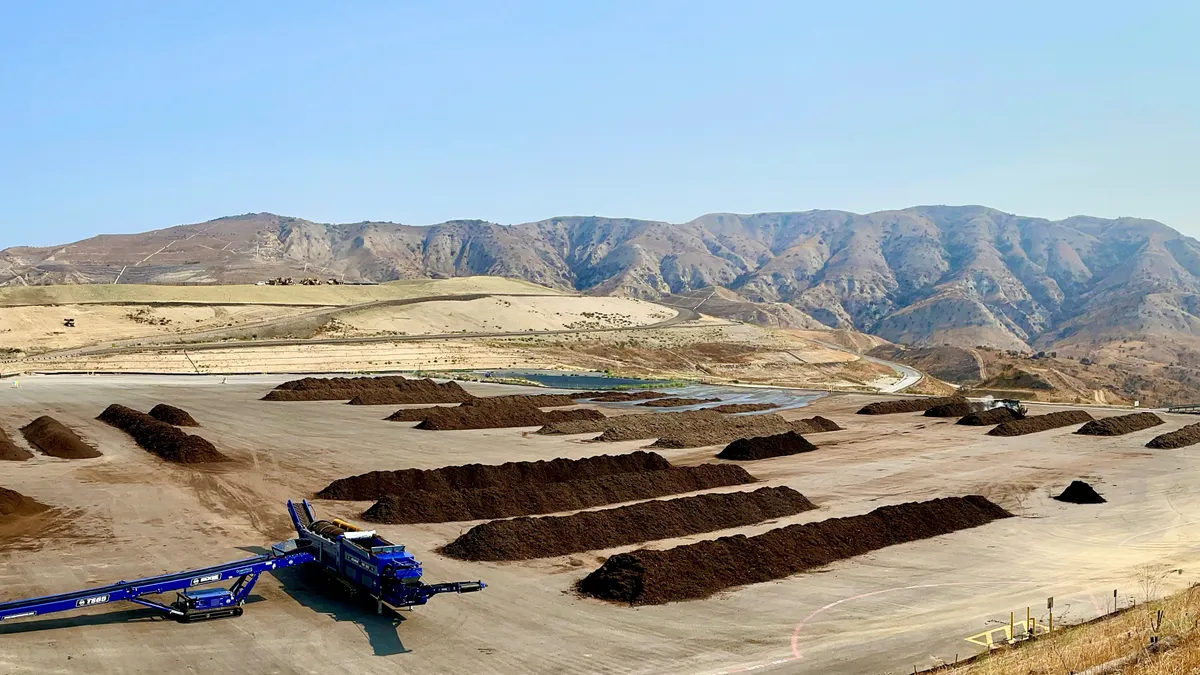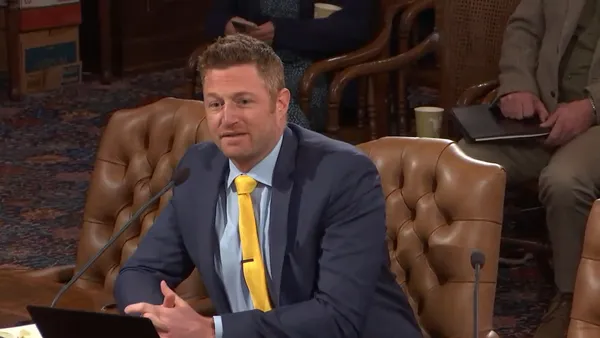Editor’s note: This is the third in a multipart series exploring the market effects of California’s sweeping organic waste reduction law, SB 1383.
Local governments are at the forefront of implementing California’s shift toward universal organics recycling. Even where those governments have been working on the issue for years, however, getting ready for SB 1383 has been a challenge.
One factor has been the regulatory timing. While the law itself was signed in September 2016, the final regulations weren’t published until late 2020, after multiple revisions. These regulations were set to be enforceable by Jan. 1 of this year, a time frame many considered too short, as some jurisdictions were waiting to see the final guidelines before they proceeded. Then came the COVID-19 pandemic.
“Basically, cities lost a year and a half in trying to get this implemented,” said Tracie Onstad Bills, executive director of the California Resource Recovery Association and a vice president at SCS Engineers. She cited one city that had to pause its planned delivery of organics recycling containers during the fateful week of March 16, 2020, for example.
Today, readiness varies widely from Bay Area organics recycling stalwarts, to larger cities still rolling out their programs, to smaller jurisdictions seeking targeted exemptions. Numerous localities already have residential organics programs, driven in some cases by county or local policies. Yard waste collection is widespread throughout the state, and jurisdictions were already gearing up for commercial organics collection due to an earlier law, AB 1826 of 2014, but many still had major work left to do on that front. Within recent months, local governments have been making far-reaching, multimillion-dollar decisions on a near-weekly basis.
In late 2021, Gov. Gavin Newsom signed a law (SB 619) to give local governments some leeway before expensive compliance fees kick in, and more of them have been taking the required steps to pass required organics recycling ordinances, arrange collection and processing contracts as needed, then begin education and implementation. Local jurisdictions have also welcomed newly allocated funding in the FY23 budget, but cost remains a key issue, with the changes required by SB 1383 resulting in sizable collection-rate increases in many cases. And despite these steps, it could still be years until everyone is fully ready to go.
“This is an enormous lift. We’re talking about the largest infrastructure deployment since single-stream recycling,” said Yaniv Scherson, chief operating officer of organics recycler Anaergia. “This is going to take time.”
SB 1383 implementation timeline
Finding the money
Prior estimates from California’s Department of Resources Recycling and Recovery (CalRecycle) have put the potential cost of implementing SB 1383 at $20.9 billion through 2030, with a potential $17 billion economic benefit in the same period. Because the law is an unfunded mandate, much of the economic effect lands on local jurisdictions and their ratepayers.
A November 2020 League of California Cities survey, which had 194 respondents, found that a majority of jurisdictions expected to implement double-digit rate increases in the next three years. While multiple factors played into that expectation, including the ongoing shift in recycling markets and processing fees, respondents cited SB 1383 and the need for organics recycling infrastructure as lead factors. The group recently solicited responses for an updated survey amid rising costs due to inflationary and supply-chain factors, but it has communicated in this year’s budget process that the trend continues.
While CalRecycle recognized the coronavirus was likely to affect local implementation capabilities in an August 2020 progress report, when the pandemic was still in its early stages, the agency ultimately concluded that “to meet climate change goals and to protect human health and the environment from negative impacts of greenhouse gas emissions, California must not delay the implementation or change the diversion or compliance goals set in SB 1383.”
The general consensus among many of the industry professionals interviewed for this series was also that SB 1383 implementation should not be delayed further, despite the current economic factors.
“California is facing this pandemic crisis, which is leading into an economic crisis. Cities aren’t seeing as much franchise fee revenue because commercial businesses are closing. So how are they going to enact organics recycling at a time when they’re seeing less money?” asked Rachel Oster — principal of Diversion Strategies, who has been working with haulers and jurisdictions around the state on creative approaches to getting ready — in the summer of 2021. “At the same time, we have the devastating wildfires showing us we need to enact these climate policies now.”
SB 619 delays potential enforcement penalties on jurisdictions until 2023 as long as they submitted a notice to comply by March of this year. Penalties on jurisdictions can range from $500 to $10,000 per day depending on the scale of a violation. While delaying penalties was appreciated by local governments, it isn’t seen as having a substantial impact overall. Some people have said certain jurisdictions that were behind on their preparations chose not to ask for this consideration, as that would have required them to lay out specific dates for planned compliance. Either way, the goal for all involved is to keep making progress as quickly as possible.
“Cities are absolutely [doing] everything they possibly can to be in compliance with SB 1383. SB 619 is not a get-out-of-jail-free card,” said Derek Dolfie, a legislative representative with the League of California Cities. “It’s really not delaying anything as far as implementation goes. It’s really just providing some protection from penalties as cities get this big, mammoth program off the ground.”
The league has been among the leading voices advocating for more local funding for SB 1383 implementation during the annual state budgeting process. CalRecycle, which says it is sympathetic to the challenge that local jurisdictions face, previously touted $140 million in grant funding from it and other California state offices for organics recycling, edible food recovery and related projects as of 2020. Stakeholders have continued advocating for more.
Last May, numerous groups (including major industry companies, such as WM and Republic Services) sent a letter to Newsom calling for $400 million in budget funding via CalRecycle for infrastructure and implementation. Following a budget surplus, Newsom and state legislators ultimately provided an additional $60 million in funding for local organics recycling grants. This brought the overall funding for organic waste infrastructure and implementation to $168 million during the 2022 fiscal year. The total is now $348 million when including FY23 funding, but the gap is still wide.
Another pending bill, SB 45, would require CalRecycle to take a more direct role in providing funding assistance for local jurisdictions when such funding is allocated by the legislature. While the proposal has seen support from Los Angeles council members, among others, it hasn’t fully advanced yet.
This spring, the League of California Cities, along with waste agencies representing jurisdictions from throughout the state as well as the Solid Waste Association of North America’s local chapter, sent a letter advocating for another $180 million in funding for SB 1383 implementation in the FY23 budget. Citing testimony from CalRecycle Director Rachel Machi Wagoner, the group noted that the agency had received an estimated 470 applications to access the prior year’s $60 million — far more than it could fund.
Speaking separately from the hearing, Wagoner said her agency is working closely with jurisdictions, but implementation is “ultimately their responsibility,” and she’s optimistic about the potential for further private-sector investment.
“A lot of jurisdictions, especially given the pandemic, are a little bit behind where they would want to be,” she said. “I have a really good feeling that over the next two years, we're really going to get, if not to 100%, very close to 100% compliance.”
According to a recently finalized preliminary budget agreement between legislators and Gov. Newsom, CalRecycle will receive the full $180 million allocation from the state’s Greenhouse Gas Reduction Fund.
Foundational questions
While the source of funding remains a key question for jurisdictions, they also face financial and operational decisions that will affect a vast range of stakeholders.
According to a 2018 CalRecycle analysis, SB 1383 “will affect all of the approximately 540 jurisdictions in California; millions of households; thousands of businesses; hundreds of haulers, food recovery organizations; hundreds of material recovery facilities, processors, recyclers, landfills; dozens of local government environmental enforcement agencies; all schools, federal and state agencies and some end users of recycled organic products.”
The regulations allow jurisdictions to request exemptions from certain requirements — based on factors such as population and elevation — and CalRecycle has reportedly received at least 500 such requests for certain areas. While the agency has granted dozens of waivers this year on a rolling basis, the system was designed for SB 1383’s targets to be achievable regardless, it says, and the vast majority of state residents will still be covered.
For the jurisdictions that are working to launch or refine their programs, increased costs are seen as largely unavoidable. A 2020 report R3 Consulting prepared for CalRecycle laid out this case based on a survey of existing programs and upcoming needs.
“Without appropriate, potentially significant adjustments to customer rates, jurisdictions may be unable to fund the organics collection services required under SB 1383,” the report states. “Jurisdictions should also be prepared to explain to their staff and customers that while rate increases are understandably unpopular, they are an unavoidable consequence of the state-mandated organics collection program.”
At the time of R3’s survey, green waste collection was by far the most common service that jurisdictions were offering for single-family and multifamily residential customers, followed by mixed organics service that co-collects food waste and yard waste. On the commercial side, food scrap-specific programs were the most common due to the nature of that waste stream as well as existing requirements under AB 1826.
Still, cost is just one consideration for jurisdictions, numerous experts noted, as they are deciding how to comply.
Those with more-established programs may pursue the “performance-based” category under SB 1383, which requires a three-cart system, and at least 90% access to residential and commercial customers, but less auditing. This approach also requires jurisdictions to have a maximum annual average of 25% organic material thrown away in gray carts (the designated color for waste carts under SB 1383 regulations). This is a level that even the most seasoned local programs are likely not meeting on a regular basis. The more common path is expected to be “standard” source-separated collection, which allows for a range of cart configurations but also has more regular auditing and reporting requirements.
WM considers this a critical decision point for its customers that will then inform the type of processing infrastructure they’ll want to use (depending, in part, on regional options) as well as how the program will be rolled out. “If you are working with a city that has already moved to high participation,” then the performance-based model may make sense, but “most are not choosing that,” said Alex Oseguera, the company’s state director of government affairs.
Athens Services, which is among the largest haulers and organics recyclers in the Los Angeles market, said some of the jurisdictions it works with will be pursuing the performance-based model. Executive Vice President Gary Clifford said SB 1383 has prompted many of its jurisdictions with one-cart programs to now choose different options. Among the smaller number of Athens’ customers sticking with mixed waste programs, something the company specializes in, two-cart collection has become a more common choice.
Clifford said Athens aims to customize its approach for each jurisdiction, sometimes offering smaller rate increases that can be amortized over a longer contract term because “we’d rather make a slow nickel than a quick dime.” As a former mayor and council member in the city of Glendora, Clifford said it’s important to understand the pressures local decision-makers face when implementing major state laws.
“Our elected officials support the bill. They’re not happy that it’s an unfunded mandate,” he said. “We’re really trying to help our elected officials have a palate to accept the bill.”
Regardless of the path to compliance, jurisdictions and haulers will need to be even more focused on education and contamination reduction strategies — not to mention related requirements around edible food recovery and procurement, which are newer even for the most established programs. While there is still plenty of discussion about which approach will be the most effective in the long term, and decisions made now may be locked in for years to come, Dolfie said the main priority for many League of California Cities members is just making sure they’re meeting the base requirements.
“We’re all individual laboratories, and I’m confident that some cities out there will find the magic formula to make this work [that] we’ll be able to scale up statewide,” he said. “The primary goal of all our cities is to be as fully compliant as possible as soon as possible.”
Stay tuned for Part 4, which will take a close look at how local jurisdictions — from some of California’s largest cities to its more remote desert areas — are tackling SB 1383 implementation.








